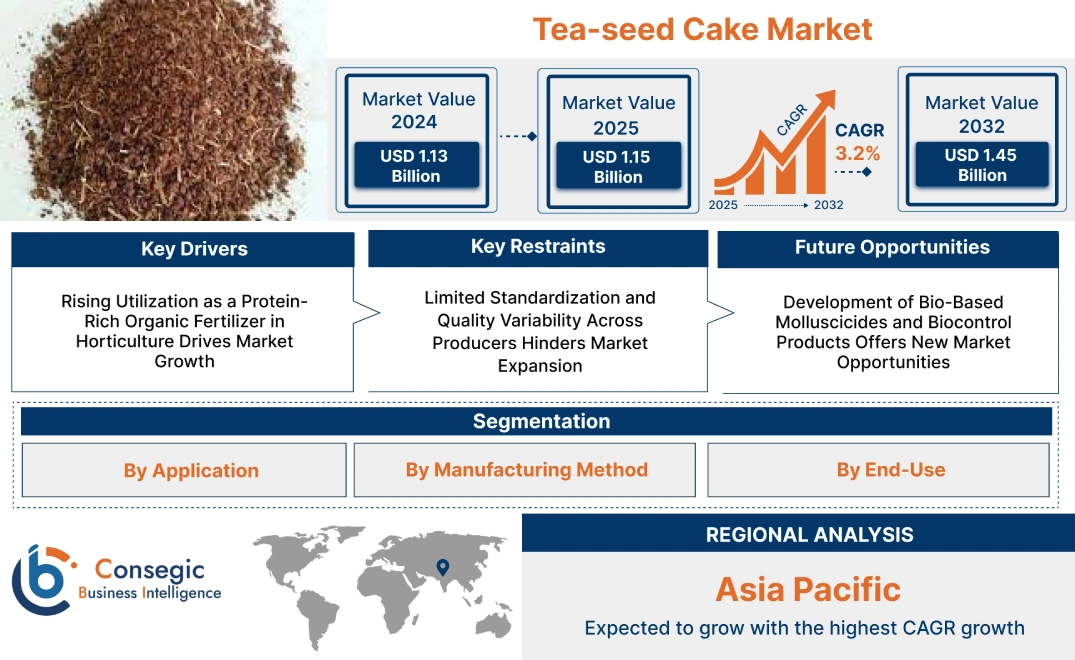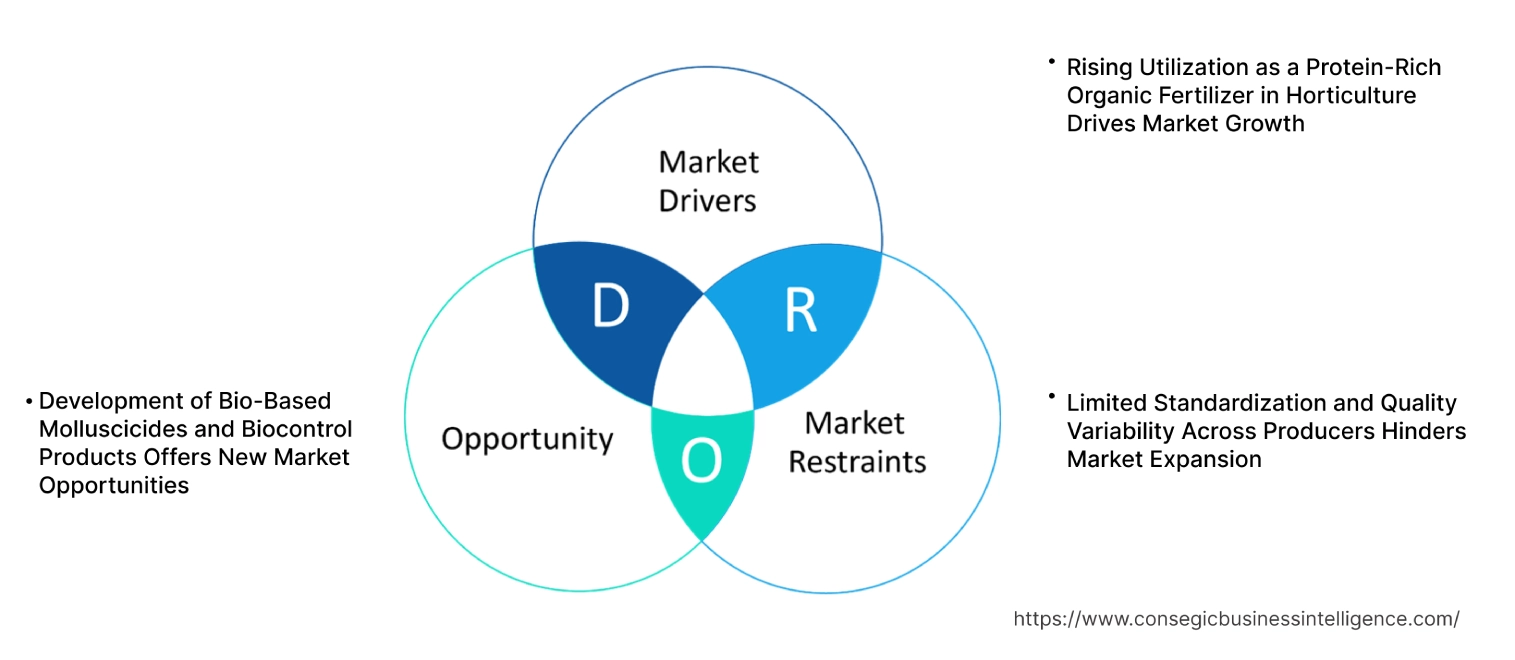- Summary
- Table Of Content
- Methodology
Tea-seed Cake Market Size:
Tea-seed Cake Market size is estimated to reach over USD 1.45 Billion by 2032 from a value of USD 1.13 Billion in 2024 and is projected to grow by USD 1.15 Billion in 2025, growing at a CAGR of 3.2% from 2025 to 2032.
Tea-seed Cake Market Scope & Overview:
Tea-seed cake is a byproduct obtained after oil extraction from Camellia seeds, widely used in agriculture, aquaculture, and natural pesticide formulations. It contains saponins, proteins, and other bioactive compounds that provide insecticidal and molluscicidal properties while enriching soil quality. This material serves as both an organic fertilizer and pest control agent in environmentally conscious farming systems.
Key features include biodegradability, high organic matter content, and effective pest suppression. Its nutrient profile supports plant growth, improves soil texture, and reduces reliance on synthetic additives. In aquaculture, it is used to eliminate unwanted species before fish stocking, contributing to pond health and productivity.
Organic farmers, aquaculture operators, and land restoration projects utilize the byproduct for its dual benefits of soil enrichment and pest control. Its natural origin and multifunctional characteristics make it a valuable input across sustainable agricultural practices and eco-friendly aquaculture systems.
Key Drivers:
Rising Utilization as a Protein-Rich Organic Fertilizer in Horticulture Drives Market Growth
The increasing focus on soil fertility restoration and residue-free cultivation is driving the adoption of organic fertilizers in horticulture. Tea-seed cake, derived as a byproduct of camellia oil extraction, contains essential macro-nutrients such as nitrogen, phosphorus, and potassium, along with organic matter and plant proteins. When applied to fruit orchards, nurseries, and specialty crops, it promotes microbial activity, enhances root strength, and improves nutrient retention capacity in the soil. Its ability to gradually release nutrients supports sustained plant growth and reduces leaching losses compared to synthetic fertilizers. Additionally, its natural saponin content deters root pests, offering dual functionality as a fertilizer and biopesticide. The growing demand for inputs that align with organic certification standards and sustainable farming models has elevated its role in high-value horticulture. This trend is expected to contribute significantly to tea-seed cake market expansion.
Key Restraints:
Limited Standardization and Quality Variability Across Producers Hinders Market Expansion
A major challenge in the commercialization of tea-seed cake is the inconsistency in product quality across small and regional producers. Variations in oil extraction methods—ranging from cold pressing to solvent-based techniques—impact the concentration of bioactive compounds and nutrient levels in the residual cake. This lack of uniformity creates difficulties in developing formulation benchmarks for applications such as organic fertilizer or biopesticide. In export markets, buyers require clarity in saponin content and residual oil percentages, which are not always reliably documented. These inconsistencies reduce buyer confidence and restrict bulk procurement across institutional segments such as commercial farming cooperatives or fertilizer manufacturers. Additionally, the absence of regulatory grading or labeling frameworks further limits traceability and compliance. The resulting uncertainty affects demand predictability and acts as a constraint on broader tea-seed cake market growth.
Future Opportunities :
Development of Bio-Based Molluscicides and Biocontrol Products Offers New Market Opportunities
The growing shift toward bio-rational pest management is creating strong demand for effective natural molluscicides in rice paddies, aquaculture systems, and organic farms. Tea-seed cake, rich in triterpenoid saponins, exhibits potent molluscicidal action against apple snails and other soft-bodied aquatic pests. Its biodegradability and minimal impact on non-target species make it a promising candidate for biopesticide formulation. Research institutions and agri-input manufacturers are investing in extract standardization and water-dispersible formulations to ensure application precision and dosage efficiency. With increasing regulatory scrutiny on chemical pesticides, stakeholders across Asia-Pacific and Latin America are seeking compliant, eco-friendly alternatives. These trends are expected to accelerate product innovation and market penetration. The alignment of this product’s functionality with sustainability goals, environmental compliance, and integrated pest management practices signals strong tea-seed cake market opportunities for the near future.
Tea-seed Cake Market Segmental Analysis :
By Application:
Based on application, the tea-seed cake market is segmented into animal feed, fertilizer, insecticide, pesticide, and molluscicide.
The fertilizer segment held the largest tea-seed cake market share of 35.2% in 2024.
- Tea-seed cake is widely used as an organic fertilizer due to its natural nitrogen and saponin content.
- The need for eco-friendly, chemical-free soil conditioners is driving its adoption across organic farming practices.
- Segmental analysis shows that its biodegradable nature improves soil structure and enhances nutrient absorption.
- As per tea-seed cake market trends, its increasing use as fertilizers in horticulture and high-value crop cultivation is driving segment growth.
The molluscicide segment is expected to experience the fastest CAGR during the forecast period.
- It is a potent natural molluscicide, highly effective in aquaculture for clearing unwanted snails and pests.
- The need for non-toxic pond-cleaning agents is increasing in integrated and eco-aquaculture systems.
- Market trends highlight increased preference over synthetic chemicals due to lower environmental risk.
- Thus, this segment is contributing significantly to the tea-seed cake market expansion as sustainability becomes a key focus in aquaculture.
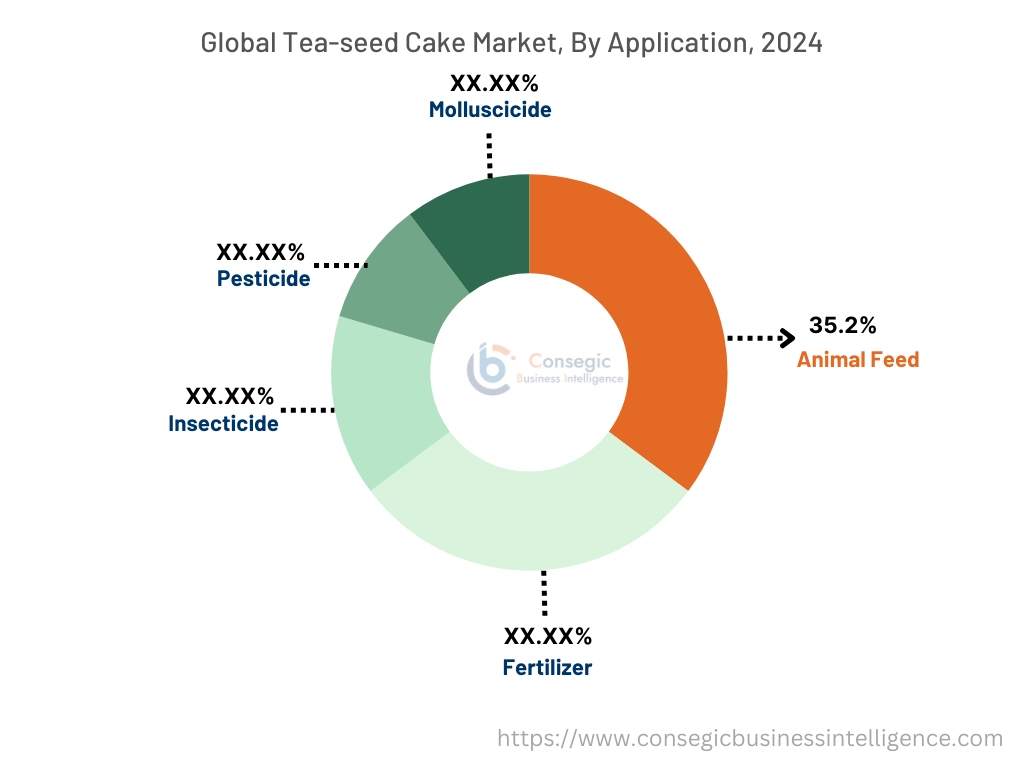
By Manufacturing Method:
Based on manufacturing method, the market is segmented into mechanical extraction, chemical extraction, solvent extraction, and others.
The mechanical extraction segment held the largest market share in 2024.
- Mechanical extraction retains natural bioactive compounds, making the resulting cake more effective in agricultural and animal feed uses.
- The need for cold-pressed and minimally processed materials aligns with the rise in organic farming practices.
- Tea-seed cake market analysis suggests mechanical methods are preferred due to their simplicity and cost-effectiveness in rural processing units.
- As per market trends, the investment of small and medium enterprises in mechanical extractors for localized production is propelling segment expansion.
The solvent extraction segment is expected to witness the fastest CAGR during the forecast period.
- Solvent extraction allows maximum yield of saponins and other active ingredients, enhancing the functional quality of the byproduct.
- The need for high-purity product in pesticides and molluscicides is boosting solvent-based processing.
- Market trends show a growing number of industrial processors adopting solvent extraction for commercial-scale operations.
- Thus, as precision agriculture and clean aquaculture grow, this method is projected to drive the tea-seed cake market growth.
By End-Use:
Based on end-use, the tea-seed cake market is segmented into agriculture & horticulture, aquaculture & fisheries, animal husbandry, chemical industry, and others.
The agriculture & horticulture segment held the dominant tea-seed cake market share in 2024.
- The use of tea-seed cake as a natural fertilizer, soil conditioner, and pest repellent supports its widespread adoption in crop farming.
- The need for organic input solutions is growing with expanding certification standards and consumer preferences.
- Tea-seed cake market analysis highlights that the product’s dual function (fertilizer + pesticide) enhances crop yield while reducing input costs.
- As per segmental trends, there has been an increase in trials of high-value horticultural crops such as tea, vegetables, and fruits.
The aquaculture & fisheries segment is projected to experience the fastest CAGR.
- In aquaculture, it is used to eliminate harmful aquatic pests before stocking ponds with fry or fingerlings.
- The need for organic aquaculture inputs is increasing, particularly in Asia-Pacific countries with large freshwater farming sectors.
- Tea-seed cake market trends suggest rapid uptake in integrated farming systems where both aquaculture and crop farming are practiced.
- Thus, with a shift toward natural water treatment agents, this segment is a key contributor to market expansion.
Regional Analysis:
The regions covered are North America, Europe, Asia Pacific, the Middle East and Africa, and Latin America.
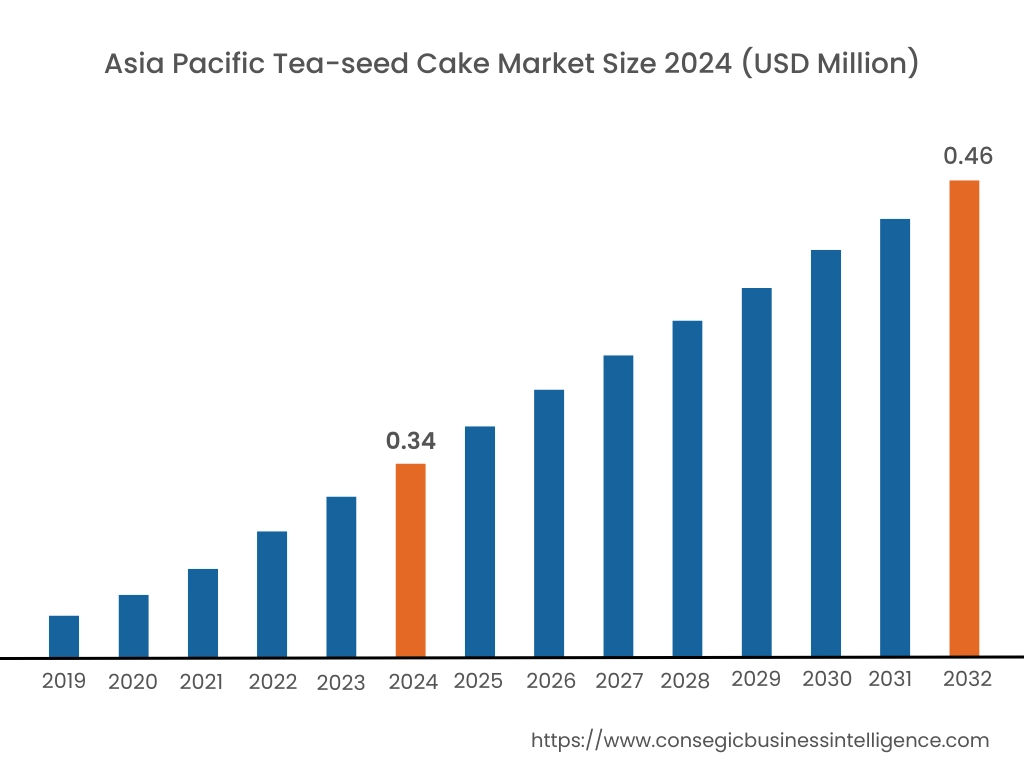
Asia Pacific region was valued at USD 0.34 Billion in 2024. Moreover, it is projected to grow by USD 0.35 Billion in 2025 and reach over USD 0.46 Billion by 2032. Out of this, China accounted for the maximum revenue share of 49.6%. Asia-Pacific dominates the tea-seed cake market in both consumption and production, led by countries such as China, India, and Vietnam. This region has long recognized its multifunctional use in agriculture, aquaculture, and natural household cleaning products. The traditional value of this byproduct in integrated pest control, weed suppression, and water purification sustains high regional demand. Moreover, growing support for eco-agriculture and the shift toward organic farming practices are fueling market growth. Analysis of regional activity highlights significant innovation in formulation and processing, presenting a robust tea-seed cake market opportunity in both domestic and export channels.
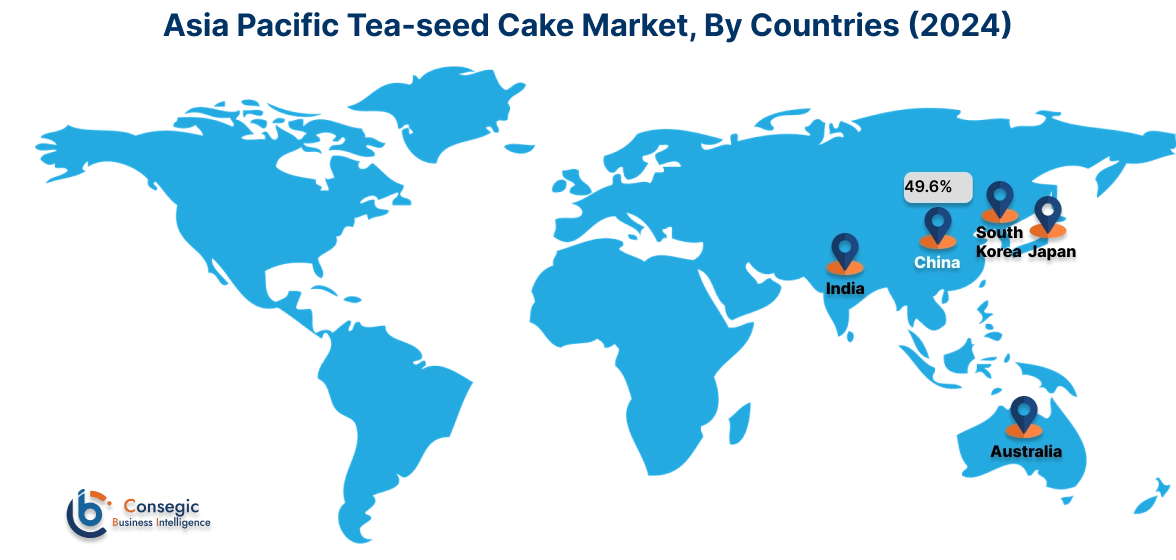
North America is estimated to reach over USD 0.41 Billion by 2032 from a value of USD 0.31 Billion in 2024. In North America, the market for tea-seed cake is emerging slowly, driven by rising awareness of sustainable agricultural inputs and natural soil conditioners. The growing inclination toward organic farming and eco-friendly pest control in the U.S. and Canada has sparked interest in tea-seed cake as a natural fertilizer and molluscicide. Although the market is relatively niche in this region, the demand is expected to build momentum as consumers and growers continue to adopt low-chemical farming solutions. Analysis suggests that ongoing research in biodegradable agro-inputs may support steady market traction in the near future.
Europe holds moderate presence in the global tea-seed cake industry, primarily due to its stringent environmental regulations and growing focus on circular agriculture. Countries such as Germany, France, and the Netherlands are integrating natural agricultural supplements into soil enrichment and pest control strategies. The product’s natural saponin content aligns with the region’s sustainability goals, particularly within organic certification standards. Market analysis reveals increasing demand from organic vineyards and specialty crop growers, making this region a viable zone for expansion through targeted education and supply chain alignment.
Latin America presents an emerging tea-seed cake market demand, with notable potential in countries like Brazil, Colombia, and Peru. As the region increasingly adopts organic and regenerative farming systems, there is growing interest in sustainable agricultural inputs. Its use in improving soil fertility and controlling aquatic pests in fish farms has begun to gain attention. Analysis of agricultural cooperatives and local sustainability programs points to rising acceptance, especially among smallholder farmers, which could enhance long-term growth prospects.
The Middle East and Africa region is still in the early stages of adoption, with limited but expanding awareness of the benefits associated with tea-seed cake. In select countries such as South Africa, Kenya, and the UAE, the market is being shaped by initiatives promoting organic farming and integrated pest management. Although current penetration remains low, the region holds untapped potential, particularly in arid and semi-arid areas where soil conditioning and organic solutions are increasingly sought after. Continued analysis suggests that regional development programs and international partnerships may accelerate growth in the medium term.
Top Key Players and Market Share Insights:
The tea-seed cake market is highly competitive with major players providing products and services to the national and international markets. Key players are adopting several strategies in research and development (R&D), product innovation, and end-user launches to hold a strong position in the global tea-seed cake market. Key players in the tea-seed cake industry include -
- Farong Marine LLP (India)
- Blue Weight Biotech LLP (India)
- Anhui Huayin Camellia Oil Co., Ltd. (China)
- Xian Pincredit Bio-Tech Co., Ltd. (China)
- Gih Hwa Enterprise Co., Ltd. (Taiwan)
- Royals Marine Food Pvt. Ltd. (India)
- Aksu Vital Natural Products and Cosmetics (Turkey)
- Joshi & Company (India)
- Gzig Giants Impex Pty Ltd (South Africa)
Tea-seed Cake Market Report Insights :
| Report Attributes | Report Details |
| Study Timeline | 2019-2032 |
| Market Size in 2032 | USD 1.45 Billion |
| CAGR (2025-2032) | 3.2% |
| By Application |
|
| By Manufacturing Method |
|
| By End-Use |
|
| By Region |
|
| Key Players |
|
| North America | U.S. Canada Mexico |
| Europe | U.K. Germany France Spain Italy Russia Benelux Rest of Europe |
| APAC | China South Korea Japan India Australia ASEAN Rest of Asia-Pacific |
| Middle East and Africa | GCC Turkey South Africa Rest of MEA |
| LATAM | Brazil Argentina Chile Rest of LATAM |
| Report Coverage |
|
Key Questions Answered in the Report
How big is the Tea-seed Cake Market? +
Tea-seed Cake Market size is estimated to reach over USD 1.45 Billion by 2032 from a value of USD 1.13 Billion in 2024 and is projected to grow by USD 1.15 Billion in 2025, growing at a CAGR of 3.2% from 2025 to 2032.
What specific segmentation details are covered in the Tea-seed Cake Market report? +
The Tea-seed Cake market report includes specific segmentation details for application, manufacturing method and end-use.
What are the end-uses of the Tea-seed Cake Market? +
The end-uses of the Tea-seed Cake market are agriculture & horticulture, aquaculture & fisheries, animal husbandry, chemical industry and others.
Who are the major players in the Tea-seed Cake Market? +
The key participants in the Tea-seed Cake market are Farong Marine LLP (India), Blue Weight Biotech LLP (India), Anhui Huayin Camellia Oil Co., Ltd. (China), Xian Pincredit Bio-Tech Co., Ltd. (China), Gih Hwa Enterprise Co., Ltd. (Taiwan), Royals Marine Food Pvt. Ltd. (India), Aksu Vital Natural Products and Cosmetics (Turkey), S. Joshi & Company (India) and Gzig Giants Impex Pty Ltd (South Africa).
